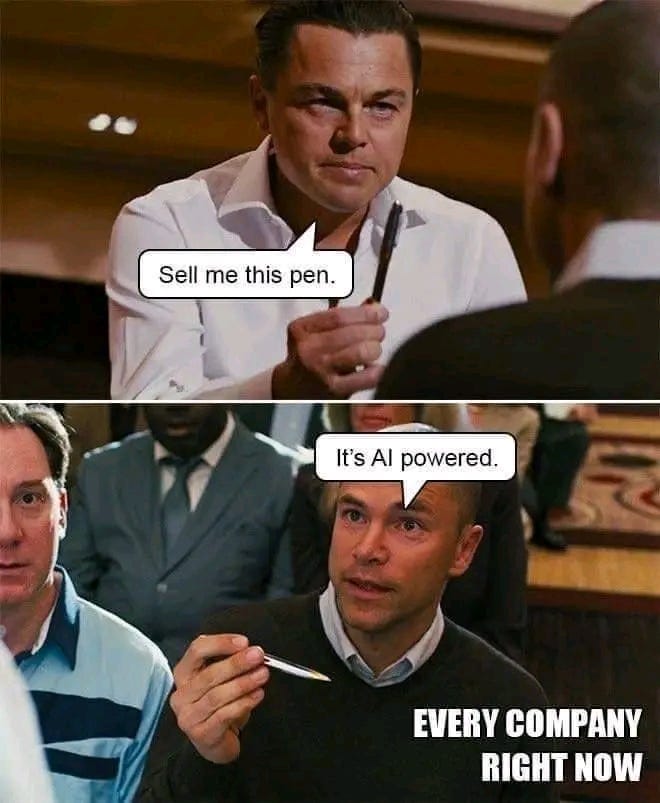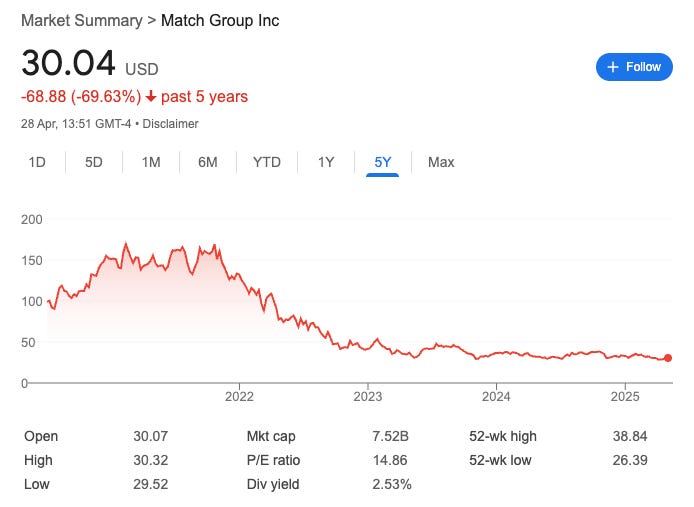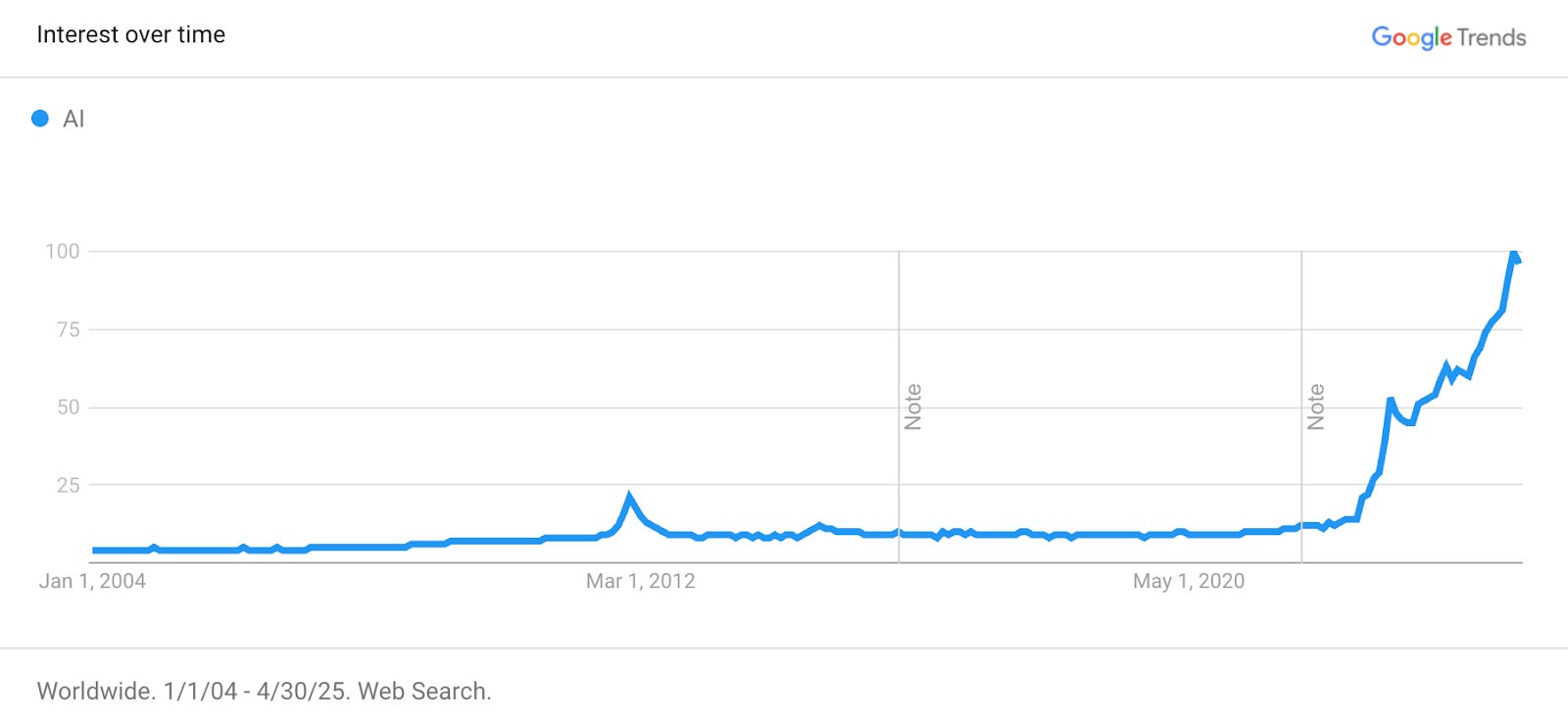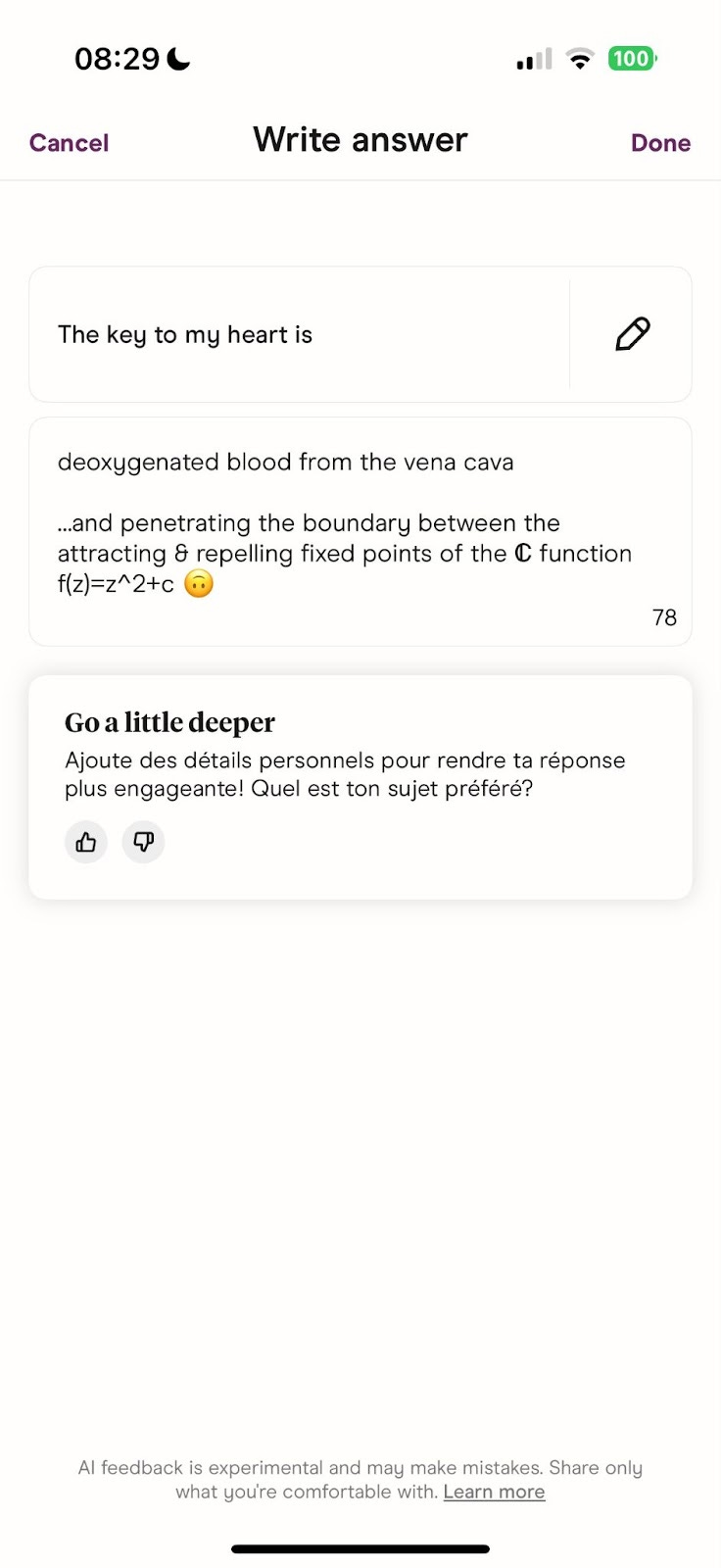Do we need AI in dating apps?
Cross-posted on Substack.
In honor of International Masturbation Month1, I’m obviously going to write about the antithesis of love: dating apps2 😍 Just kidding. Kinda. Anyway. I’ll focus on people’s latest fixation: AI dating apps. My thoughts are mostly on the heterosexual, cisgender ecosystem.3
For those who don’t know me, I’m uniquely qualified to talk about this topic because I’ve been obsessed with the mechanisms of dating apps since middle school and I’ve been studying AI for the past ten years in both academia and industry. And because I love being an armchair sociologist.
Lately, maximizing shareholder value has resembled this scene from The Wolf of Wall Street.

And Match Group – the company with the largest portfolio of online dating services – announced plans to launch AI features in their dating apps. *Cough, maybe because MTCH stocks have been going down on their shareholders more often than their spouses, cough.*

But in Match Group’s defense, it’s been an industry-wide trend. (Except Grindr.4 Grindr grinds.5)
So, why have dating app stocks been plummeting? How can dating be improved with technology? Will AI save online dating? We’ll explore the answers in this post.
To understand AI in dating apps, we first need to understand dating apps (Section 1) and their existing problems (Section 2). We then cover the basics of AI (Section 3), the problems with modern AI (Section 4), and the current state of AI in dating apps (Section 5). We then build our answer to the titular question (Section 6), “Do we need AI in dating apps?” In each section, I’ll focus on the topic as it relates specifically to AI and dating apps.
1. Background on dating apps
Dating apps come in many shapes and sizes.
Remember the aforementioned Match Group? You might have heard of some of their services, like Tinder (“The Hookup App”) or Hinge (“The Relationship-y App”). Across all of their services, including the less popular OkCupid (“The Questions App”) or The League (“The Elitist App”), they have 14.6 million6 paying users. Then, there’s companies like Bumble (“The Basically Tinder App”) with 2.8 million7 paying users. There are many more apps for niche communities, e.g. Grindr (“The Gay App”), Feeld (“The Kinks App”), HER (“The Lesbian App”), apps for ethnic groups, apps for music tastes, apps for restaurant tastes, and so much more. There are constantly new dating apps advertised on public transportation, dating app ideas from your friends and their mothers, and non-dating apps that want to become dating apps8. And because we don’t have enough dating apps, these days, there are AI dating apps.
So how did we get here?
Although computerized dating services were documented since the 1950s, the first service credited with making online dating a profitable business was Match.com9 launched in 1995. They became profitable by adapting the traditional paid matchmaking model to the internet via our favorite subscription-based system – plus modest fees to access premium features such as messaging.10 This original monetization strategy that made Match.com profitable is largely still the monetization strategy used by dating apps today, albeit with more complicated payment tiers and inflation.
But as complicated as the payment tiers are, the underlying mechanisms of these apps are simple. You are shown a person, and you either indicate “yes, I want to match with them” or “no, I do not want to match with them”. The variation between the apps is typically in the way you are shown new people, the method you use to match or reject them, and most importantly, the pool of available people. To maintain profitability, these apps limit your access to your potential matches. Unless, of course, you want to pay for an extra swipe 😉 Maybe this isn’t all that surprising given most online games are pivoting to a pay-to-win scheme.11
This might explain why today, the average American dating-app user spends 51 minutes a day swiping and is less happy with their relationship status. And this is just the start of their problems.
2. Problems with dating apps
Um, to be honest, too many to fit on one blog post. But just to list a few: gender imbalances, ghosting, unwanted behaviors, infidelity, restrictive filtering, unrealistic expectations, et cetera, et cetera. Beyond the immediate, obvious, and more-or-less-universal problems, people experience individual problems12 and undesirable downstream behavioral consequences.
Let me explain as an armchair sociologist.
Individual problems arise as a result of individual differences. On the supply side, each person offers different qualities as a romantic partner. On the demand side, each person desires different qualities in a romantic partner. As a result, there are many theories on and advice about dating. In fact, most new dating app ideas13 are notoriously gimmicky14 because they attempt to solve these individual problems instead of the fundamental problems.
Undesirable downstream behavioral consequences occur as a result of negative reinforcement. These consequences often cause nebulous yet nefarious problems, such as unwanted situationships. The standard argument is:15
- Dating apps separate males into the “haves” versus “have nots”.16
- The “have nots” have little female interest, which creates a scarcity mindset.
- The “haves” have lots of female interest, which creates a non-committal mindset.
- The men who can get dates and want to commit quickly leave the dating pool.
- This leaves everyone else in a bunch of situationships or hopelessly single.
- Then men wonder, “Why won’t women date me?”, and women wonder, “Why won’t men commit to me?”
- These consequences are felt even if you are not on the apps yourself.
Other consequences include phantom optionality. “Phantom optionality” is what I call choices that seem like options but in reality are not.17 Women receive an overwhelming amount of attention on dating apps, but they are often only interested in a minority of these men who may have an incompatible dating goal. Women have the competitive advantage on the dating market, but men have the competitive advantage on the marriage market.18 Unfortunately, this true lack of optionality is often not immediately obvious, leading to suboptimal behavior such as low-effort texting, ghosting, or unrealistic standards19.
Another undesirable behavioral consequence of dating apps is the amplification of judgment. The entire mechanism of dating apps rely on the expectation of judgment for every profile. Without much prior information, users resort to evaluating physical appearances, which are less important offline, and brief bios, which aren’t representative of one’s personality.
On the business side, a fundamental problem of dating apps is the incentive misalignment. If users wanted to find a life partner, a dating app that successfully matches a couple would lose two users. However, dating apps profit from keeping paying customers around. Christian Rudder, the Co-Founder of the dating app OkCupid, wrote about why you should never pay for online dating. Times have changed given the pay-to-win games era, but the messed up economics remain.20
Now, if you wanted to find hookups21, dating apps are absolutely brilliant for that.
3. Background on AI
Since you’re reading this, I assume you already know what AI is. But in case you don’t, here’s an introduction written by our favorite AI model, ChatGPT:
Artificial Intelligence (AI) is reshaping nearly every aspect of modern life—from healthcare and finance to entertainment, education, and retail. Its ability to process massive datasets, identify patterns, and make real-time decisions has revolutionized how businesses operate and how individuals interact with technology. In the realm of online dating, AI’s impact has been particularly striking. What once relied on static profiles and user-generated filters has evolved into a dynamic system driven by machine learning algorithms, predictive analytics, and real-time behavioral feedback. AI curates matches, detects fraud, suggests icebreakers, and even mimics human conversation, making the dating experience more personalized and efficient than ever before. As AI continues to advance across all sectors, its integration into dating apps reflects a broader shift toward data-driven, intelligent systems shaping our most personal decisions.
“AI” has grown in popularity since ChatGPT first launched in November 2022. However, the beginnings of machine learning (ML) was invented in the 1900s, and we’ve been using AI since the 2000s through image recognition in postal automation, voice recognition in Siri, disease detection in hospitals, content recommendation in Netflix, and machine translation in Google Translate.

ChatGPT is an example of the latest AI trend called “generative AI” that can generate new content based on existing data on which it’s been trained. Generative AI promises to revolutionize society by automating complex tasks that previously only humans could do and by executing tasks that previously humans nor machines could not do.
In the context of dating, generative AI can enable better personalization, scale knowledge, and fix love. Or something. Which brings us to the next section.
4. Problems with AI
AI comes at a cost.22 I’ll highlight a few of the key problems in AI as they relate to dating apps.
Modern AI models are a black box. No one understands what they truly do, and work in this field is much more of a science than it is theory. In fact, making these models understandable to humans (interpretability) and steering these models toward a particular set of preferences or values (alignment23) are open areas of research. However, our current lack of understanding could lead to both intentional and unintentional manipulation.24
Furthermore, AI homogenizes content. By flattening individuality into algorithm-friendly bits, we are at risk of losing the diversity and quirks that make us unique. This problem could potentially be exacerbated in the future when models are trained recursively on AI-generated data, leading to an effect known as “model collapse”. Thanks to AI algorithms, we already have the popular “social media look” that’s made all girls look the same.
Speaking of algorithms, AI models notoriously suffer from algorithmic biases that systematically produce “unfair”25 outcomes. We want to prevent unintended and discriminatory AI behavior, but the presence of algorithmic biases in dating can be philosophically confusing. While dating app algorithms may cause “sexual and romantic bias”, such as predicting preferences by race, the ethics of love requires further examination. That is, are we entitled to love? Are we responsible for giving everyone equal consideration of our love? Is it morally wrong to have sexual or romantic preferences for certain groups of people? Is it unjust that some groups of people are less desired than others? These are open questions with complex answers I’ll address another day.
Today, we’ve got to ask, “Where does AI get its training data?”26 Amidst the copyright battles, there are many data security and privacy issues. Unfortunately, AI companies often restrict access to information about their training data. By the way, do you know if your content is being used to improve model performance? Don’t worry, though; I’m sure the models won’t memorize those rants you trauma-dumped about your boss the other day!
5. Current AI dating apps
Problems attract attempted solutions. Currently, the main types of AI apps that relate to dating include AI companions, AI clones, AI matchmakers, and AI relationship coaches. Below, I’ll describe each type with commentary on its efficacy.
AI Companions. If you are struggling to get a real date, why not get an AI date? 👍

👍
As I’ve previously said, the place to earn loads of money is in porn and crypto, and AI companion services enter the crevices of soft porn. Ethical considerations aside, “wat r sum exampels of ai componion aps? aSkiNg foR a fRiENd”. Right, so, these AI companies include chatbots with NSFW filters, e.g. Character.ai or Replika, and chatbots without NSFW filters, e.g. Digi.ai or Kindroid or Nastia or Nomi.ai27. But unless we’re in some dystopian world, this is not quite the type of “dating” I’m imagining.28
AI Clones. AI clones is the concept from an episode of Black Mirror. They have many names, including “dating concierges” coined by Whitney Wolfe Herd, the Founder of Bumble, or “duplicates” or “synthetics” coined by George Arison, the CEO of Grindr. The idea leverages the ability to run many AI models in a massively simultaneous fashion. Each person would have a personal AI model that could perfectly replicate themselves, and these models would be paired to simulate dating outcomes.
In a perfect world, where AI clones could perfectly simulate every person, how great would it be to skip the time of dating the wrong ones and to focus on building a life with the right one?
Current AI clones, such as Ice or Volar, are first trained on your dating interests, hobbies, and personality traits before conversing with other clones (or real people). It sounds harmless in theory, but existing AI clones do not work as intended. There are growing concerns over these AI automatons that “lack the human understanding required of the relationships that people try to create with them”29. Ted Chiang wrote:
It is very easy to get ChatGPT to emit a series of words such as “I am happy to see you.” There are many things we don’t understand about how large language models work, but one thing we can be sure of is that ChatGPT is not happy to see you. A dog can communicate that it is happy to see you, and so can a prelinguistic child, even though both lack the capability to use words. ChatGPT feels nothing and desires nothing, and this lack of intention is why ChatGPT is not actually using language. What makes the words “I’m happy to see you” a linguistic utterance is not that the sequence of text tokens that it is made up of are well formed; what makes it a linguistic utterance is the intention to communicate something.
This phenomenon in chatbots is often termed “stochastic parroting” within the AI community. The heart of the problem goes back to the black-box nature of AI models, which makes us confused about the inner workings of these models and unclear about what is learned during the training process. Moreover, we must remember that these models reflect the data from the past. As we continue to grow, you change and I change and life changes.30 Every technology comes with tradeoffs, and you can answer whether AI clones are worth the risks for yourself.
AI Matchmakers. The “concierge test” is a fable passed down within the entrepreneurship community: companies should validate and refine their ideas by offering their product as a manual service. Well, lucky for AI matchmaking apps, because matchmaking has been around since the formation of civilization. We have enough evidence that a person can successfully pair two (or more) people together for the purpose of a lifelong relationship; the next step is to productize the service by enabling AI to do the same. Uhh…let me get back to this point.
Like Instagram models, AI matchmakers come in different looks and names for the same content. In no particular order, there’s Amata, Iris, Keeper, Rarebird, Sitch, and many more that need to improve their SEO. While these services differ in their user experiences, they are built using the same foundation models like OpenAI, Claude, or Gemini. Wouldn’t it be splendid if these models could predict exactly who I should date?
Fundamentally, all AI matchmakers are predictive models that make predictions on the preferences of individuals. They aim to answer the question, “What are the chances that a particular person will like your profile?” However, they are prone to suffering from the mathematical concept of “ecological fallacy”31, in which the behavior of individuals within a group will oftentimes differ from the average behavior of the group. These AI models are statistical models trained on the behavior of every human (and bot) on the internet, but they are probably sparsely trained on your behavior. That is, if you are a 25 through 35 year old Caucasian male in New York City, an AI model may be good at predicting the average voting pattern of all 25 through 35 year old Caucasian males in New York City, but it may be bad at predicting your personal vote. An AI matchmaker might be good at predicting the chances that the average female on the app will like your dating profile, but it might be bad at predicting the chances that a potential date will like your dating profile.
Now, recall our “concierge test”. The way I see it, the “concierge test” for AI matchmakers is not traditional matchmakers – despite their name. AI matchmaking fails to encapsulate the many aspects of matchmaking that make the practice successful32, including social involvement33 and pressures34, substantial financial investment35, and aligned personal goals36. Without these elements, AI matchmaking cannot scale matchmaking capabilities and, instead, suboptimally automates your dating decisions. The manual service for current AI matchmakers is swiping on dating profiles yourself, which comes with its own problems.
At the end of the day, both AI matchmaking apps and traditional dating apps are two-sided marketplaces. Both suffer and benefit from marketplace dynamics. Both require enough supply to function. And even with plentiful supply, I part this section with the age-old proverb: “The odds are good, but the goods are odd.”
AI Relationship Coaches. Luckily, if you’re a strange cat like me, there are AI relationship coaches for us! They’ll tell us how to interpret texts like “hey”, what to reply to texts like “what’s up?”, whether my pictures make me look ugly, how to sound less robotic in my bio, and other stuff. An AI relationship coach will, like, make me appear dateable.
Sarcasm aside, I think a relationship coach, similar to a tennis coach or a piano teacher, can be a useful guide for diagnosing problems and introducing solutions. Ultimately, you have to do your own work to solve your own problems, but a relationship coach can be incredibly helpful. And AI is a fantastic way to scale relationship advice. In fact, I think relationship coaching and therapy are domains where AI excels and outperforms humans. Namely, I think37 AI is exceptional for answering questions requiring the synthesis of encyclopedic knowledge and for situations in which you want an aggregate opinion. Plus, an AI relationship coach avoids awkward interpersonal moments, like when I say, “I accidentally matched with my step-brother on Tinder.”
Anyway, in no particular order, there’s Amori, this DeepAI feature, Maia, Matthew AI38, Rizz, Wingman, and many more. It’s also easy enough to prompt ChatGPT or any other language model.
Actually, now many dating apps have in-built AI tools to help improve your profile. On my Hinge profile under the prompt, “The key to my heart is”, I wrote, “deoxygenated blood from the vena cava…and penetrating the boundary between the attracting & repelling fixed points of the ℂ function f(z)=z^2+c 🙃”. (Don’t judge me too hard.)

I avoided opening dating apps for so long, but I did so for this post. You’re welcome.
I couldn’t get the AI agent to respond in English, but the French AI-generated advice translates to, “Add personal details to make your answer more engaging! What is your favorite subject?” Eh, I think it should be clear to a human who reads my response that I like clever, nerdy jokes and math. But I don’t know, this is all too perplexing for me.
My advice is to take any advice with a grain of salt.
6. Do we need AI in dating apps?
As with most things, yes and no. Mostly no.
Dating apps’ got 99 problems, but AI ain’t one.39
Sure, online dating app companies could integrate AI relationship coaches to improve users’ profiles and offer a private chat to answer dating questions. Maybe they could add suggested messaging40 responses, steering the models to help meet in person. However, the technology for AI matchmaking currently does not go beyond an attractiveness predictor and a probability based on the expected checklist items, and creating AI clones is even harder.
Anyway, dating is difficult. And the core issues with dating apps will not be fixed by AI.
Let’s dismantle the patriarchy dating apps as we know them today.41
If you found this essay useful, please cite this write-up as:
Elle. (May 2025). Do we need AI in dating apps?. elleismatic.com. https://elleismatic.com/archive/do-we-need-ai-in-dating-apps/.
or
@article{elle2025aidating,
title = {Do we need AI in dating apps?},
author = {Elle},
journal = {elleismatic.com},
year = {2025},
month = {May},
url = {https://elleismatic.com/archive/do-we-need-ai-in-dating-apps/}
}
The National Masturbation Day is May 28th, just FYI! ↩︎
I was inspired while reading this classic banger on the market for “lemons”, which I obviously immediately related to the optimal stopping problem within dating and dating apps because of my matching algorithms obsession. ↩︎
In many ways, the apps work wonderfully for LGBTQ+ communities. When you are part of a niche group searching for members of another niche group, a centralized marketplace facilitates the discovery process. In fact, this problem becomes closer to a search rather than a discovery process. I’d guess this is the thinking behind many of the smaller dating apps such as The League, for people who’ve found career success looking for other professionally successful people, or FarmersOnly.com, for people who are looking for…farmers only. ↩︎
As of May 1, 2025. This is obviously not investment advice lol, and I don’t purport to know the future. ↩︎
Apologies for my bad puns. ↩︎
As of the quarter ended December 31, 2024 based on Match Group’s investor relations website. ↩︎
As of the quarter ended December 31, 2024 based on Bumble’s investor relations website. ↩︎
I’m thinking of apps like Twitter or Strava. This isn’t a recent phenomenon, though. Back in the early 2000s, AOL and Microsoft used to have their own dating services, too. ↩︎
Of course, owned by Match Group after being incorporated as a conglomerate of Match.com and a few other sites 🙂 ↩︎
Hint, hint. Wink, wink. ↩︎
Capitalism, Babes. ↩︎
I take the perspectivist view that the understanding of dating app dynamics can only be based on a person’s perspective and is thus relative to that perspective. ↩︎
I mean, dating app ideas are solutions, and solutions are simply (supposed to be) actionable advice. ↩︎
This is my armchair-sociologist opinion, not a fact. I’m trying to get at the fact that many of these app ideas can generally be incorporated as a feature to a preexisting app. ↩︎
Most people actually don’t seem to have a baseline of what is the expected amount of interest they should receive (on dating apps and in real life). The distinction is based mostly on their self-perception. I’ve overwhelmingly observed two dominant strategies by men, divided by (1) “have nots” who believe they do not have enough options versus (2) “haves” who believe they have many options. I’m not sure that those at either extremes are happy as a result. ↩︎
I suppose “phantom optionality” is referring to the object of illusion in the “illusion of choice”. I wanted to invent a neologism. ↩︎
Sorry, I couldn’t find a source for this. As I prefaced, I’m being an armchair sociologist. Note that I am referring to the “haves” here. ↩︎
Again, there is no source for this other than my brain. Armchair sociologist! ↩︎
By the way, you are *not* single because you didn’t pay for Tinder Select, but that’s a topic for another day. ↩︎
But I don’t think casual sex is real, and I think most people who say otherwise are lying to themselves. I know, hot take. ↩︎
In fact, Dr. Luke Brunning, a Lecturer in Applied Ethics at the University of Leeds, wrote an open letter calling for regulatory protections against AI on dating apps. ↩︎
What I study, in part! ↩︎
Here is a contrived example of a misaligned AI model that could be used within a dating app. Let’s say you are using an AI version of Tinder, where you swipe left if you are not interested and swipe right if you are interested. Suppose this fictitious AI Tinder model is tasked with finding a match for a particular paying customer called “Alex”. The AI model predicts that if they show you Alex the next time you open the app, you will probably swipe left. To increase the chances that you swipe right on Alex, it may have learned that if it first shows you a series of people it predicts you will swipe right on but who does not swipe right on you, you will be more likely to swipe right on Alex. The model is unaware and unconcerned that this fosters your sense of insecurity or frustration or whatever, as long as it achieves its objective to find a match for Alex. ↩︎
I don’t think it’s fair for me to define what is “fair” in this blog. ↩︎
Llama 4 was trained on more than 30 trillion tokens! ↩︎
If you pay 😉 ↩︎
Although I believe that we probably should have the freedom to use an AI companion if we desire. But do we really have free will? ↩︎
I can attest that even after training an AI model on my text messages, the model-generated output is very much unrepresentative of “me”. ↩︎
Lol, I wrote something like this in a letter to my ex after we broke up. ↩︎
Here’s an informational Cross Validated thread about the topic. ↩︎
I couldn’t find too many studies on matchmaking outcomes, but my thoughts are based on an amalgamation of advice I’ve heard over the years and studies on arranged marriages as in traditional Indian matchmaking. ↩︎
Matchmakers often get additional context via friends and family. Some dating apps rely on friends to swipe for you, but these apps are not as popular, and many people aren’t comfortable sharing this type of information. ↩︎
The involvement of friends and family necessarily adds social pressure. There is often also cultural pressure, too, in places where matchmaking is more common practice. Of course, these pressures are often also present within a dating app context, but dating apps function on the premise of personal usage. For instance, I’d be extremely uncomfortable if my parents wanted to swipe on Tinder on my behalf. ↩︎
Matchmakers are often expensive. Of course, apps can just charge more, but they must first prove that they are worth the price. ↩︎
The one for you is someone who you are willing to make it work with and who is willing to make it work with you. I’d guess that most people who seek traditional matchmaking want to be in a forever relationship and hold the attitude that they’ll try their best to make the relationship work. RE: “Problems with dating apps” – I can’t say the same about online dating. ↩︎
Don’t quote me. This is my educated guess based on what I know about how modern AI systems work. ↩︎
It was created by Matthew Hussey, who is a real person who does relationship coaching. ↩︎
I had to do this one…it was calling me. ↩︎
Although, if you’re having trouble making conversation with someone, you probably shouldn’t date that person. Relationships are a long conversation, and you want to find someone who you feel comfortable talking with. At least, that’s my opinion. ↩︎
One of the common dating app responses is, “Let’s dismantle the patriarchy.” ↩︎